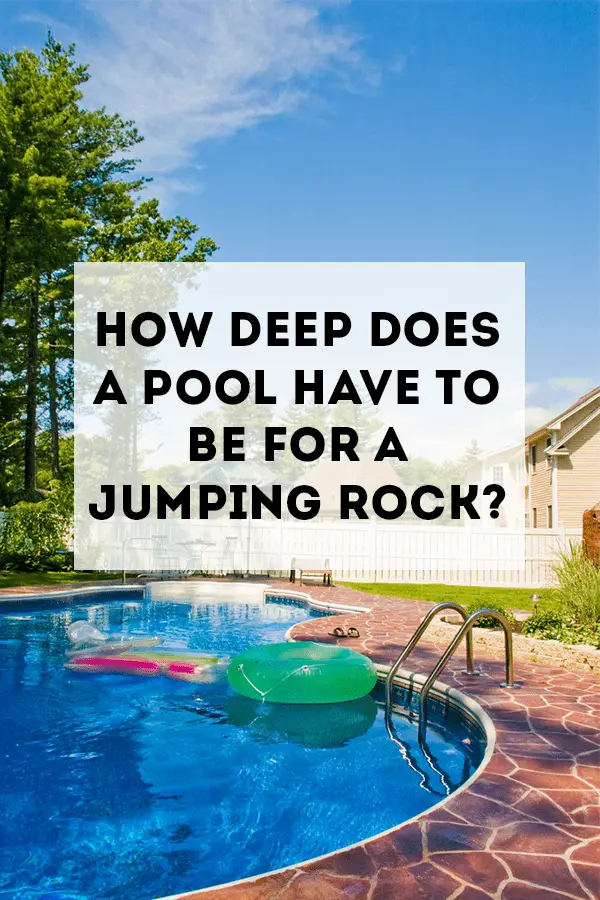
A pool in the home is one of the coolest things to have, as it provides a cool and exotic spot for relaxation. The average cost of constructing a swimming pool has reduced in the past decade and it is a
How deep does a pool have to be for a jumping rock? It is always of great importance to follow safety guidelines and requirements after installation of the jumping rocks. The ideal depth is a minimum of 8 feet but the American Red Cross recommends a minimum of 9 feet for headfirst dives.
Many pools come with different options based on the preference of each particular family. One major trend that has become popular is the installation of jumping rocks to the pool. Jumping rocks has emerged as a safer alternative to diving boards which has gone out of vogue due to the high safety risk associated with it.
Jumping Rock for Your Backyard Pool
Diving from Jumping rocks has become popular in recent years as more people partake in diving as an integral part of swimming. In addition, Jumping rocks add aesthetic value to pools and give a natural feel to the pool due to varieties of options available to choose from.
The rocks come in different sizes, shapes, colors and blend naturally with the pool making it an attractive prospect for pool owners.
Furthermore depending on the quality of materials used, jumping rocks last for years and provides a safe platform for diving. Jumping Rocks are typically situated in different levels of the pool depending on the size and design to facilitate easy diving from different depths of the pool.
Before constructing an in-ground swimming pool that would feature a jumping rock, it’s normal to be focused on the design of the pool. However, there is an important question that baffles many which is how deep should the pool be?
Standard in-ground residential pools tend to range between 4 to 6 feet, which is sufficient for basic swimming needs. However, for a jumping rock, the pool’s depth minimum has to be deeper as the higher the depth the lower the chances of accidents or injuries occurring during diving.
There are different conditions to be taken into consideration when trying to determine the correct depth for your pool for your jumping rock.
Structure of the Pool
The shape and overall design of the pool is a determining factor when considering the depth required for a jumping rock.
A standard pool with a rectangular shape would see the jumping rock situated at the deep end of the pool which is typically 8 feet. This should be a good depth for your diving needs as there is less risk of injuries and accidents.
However, pools of spiral designs need to be gauged carefully because this design means that the pool covers a longer distance which could cause discrepancies in the depth of the pool at different intersections. The minimum depth at all points where the jumping rock is situated must be above 8 feet for safety reasons.
Size of the Jumping Rock
Choosing the right pool depth when constructing your pool is also determined by the size of the jumping rock to be installed. Jumping rocks come in different sizes, providing different jumping points for diving.
It is important to note the sizes of the jumping rocks as this would guide you on the minimum depth required for different portions of the pool. For a small piece of jumping rock which would provide a little spring in the step for diving, a large depth may not be required as it would be a waste of resources if you want a small pool to swim a few laps.
Since the deeper the pool the higher the cost it could be cost-efficient to install a small jumping rock in order to meet up with safety requirements for a small pool.
However, in a situation where the jumping rock has different stages or steps for diving, it would be logical to increase the depth of the pool for safety reasons.
In this scenario, the minimum depth of the pool should be eight feet. This would militate against dangers that could occur when deep diving from a high vantage position.
Single depth or multiple depths pool
Most backyard pools have different depths beginning from the shallow end which is usually around 3 feet and transitions in increasing depth to the deep end of around 6 feet. This is usually to ensure that different members of the family can swim at different levels according to their skillset.
The younger ones begin from the shallow end while the older members of the family can swim at the deep end. There are different variations depending on the preference of the pool owner.
When it comes to multiple depth pools, it is important to ensure that the Jumping Rocks are situated on the deep end of the pool. The depth of the deep part should range from 6 feet for a small-sized jumping rock to 8 feet for a medium to large sized jumping rock.
It is also important to ensure that the transition region between different depths goes as smooth as possible. This could be achieved by increasing the length of the pool or by regulating the water flow between the two different slops.
Single depth pools are not common but it is not unusual to see a pool maintain the same length throughout its course. This is most common in homes of athletes or persons that feel comfortable swimming at a particular depth.
In this case, the minimum depth of the pool should be within the ranges of 8-10 feet when combined with a jumping rock. Jumping rocks can be situated in different points of the pool since the water level is evenly distributed.
Should You Get a Jumping Rock?
Jumping rocks, despite its suitability for diving, has its advantages and disadvantages to when considered. The problem of depth is a major factor as you would need to sacrifice a lot of space within the pool in order to increase the depth of the water.
Jumping rocks are usually made up of sandy, or rocky materials that can erode with time and may require a high level of maintenance. Also, a deep pool would need more cleaning, materials, chemicals, water and heat to operate. These processes tend to drive up the total cost of maintaining a swimming pool
Safety is also a key strength of jumping rock, you can set diving limits for your pool with the construction of jumping rocks. It is firmer on the ground unlike diving boards and protects divers from the impact of diving which is a major problem with diving boards.
Jumping Rock Cost
Jumping rock is insurance friendly, unlike diving boards. Many insurance firms tend to turn down insurance covers for homes that have a pool with diving boards installed. In most cases, the insurance companies increase the cost of insuring homes with a diving board installed.
However, jumping rocks are viewed favourably by insurance companies as a more secure platform for diving. Nevertheless, you still pay more in insurance with a jumping rock installed than a standalone pool.
The cost of building a jumping rock also depends on the materials used to design the rock and size of the rock. The price typically ranges between $300-$2000 and does not include the cost of installation which is done by a professional. There could be other additional costs included, such as changing the design of an existing pool in (length, depth or width) to accommodate the jumping rock.
When installing a jumping rock, you should pay attention that it follows safety guidelines and features. Most rocks are made of materials that help minimize slipping and allows for safer movement when wet. While some contain extra safety materials which could contribute to an increase in the cost of installation.
It is essential that you take into account the total cost of installation before planning your budget.
Important facts to note before deciding on pool depth.
- It is always of great importance to follow safety guidelines and requirements after installation of the jumping rocks. The ideal depth is a minimum of 8 feet but the American Red Cross recommends a minimum of 9 feet for headfirst dives.
- Always post relevant warnings and instructions which prohibit dives towards regions lower than 6 feet in a multi-depth pool. There should also be proper supervision for minors and beginners as regards the proper use of jumping rocks.
- When deciding pool depth also take into consideration the shape and design of the pool. There is no use adding more depth for a jumping rock when there is little space between both ends of the pool.
- The size of the jumping rock should take major importance when ascertaining the correct pool depth as multiple step rocks require more depth for the pool. Also, the material of the jumping rock is important as quality materials last long and remain durable for a long period of time.
- Always ensure that after installation of jumping rocks, the water level is checked at regular intervals. This is to ensure that the pool depth remains at the required minimum required for the safety of a diver using the jumping rock.


